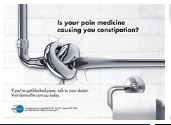Despite thirty years in practice the practice of medicine remains perplexing. Once we learn how to do something well, we can’t seem to stand our own success.
Over a century we learned to safely deliver mothers and babies, so why are we now dealing with cesarean delivery rates approaching 40% nationally. We built a blood banking system that made life-saving blood products available in minutes. Now we’ve made blood transfusion a quality assurance indicator creating dangerous counter- incentives to avoid its use. We have a cheap over-the-counter medication that will almost instantaneously stop almost all diarrhea, but now the gastroenterologists tell us it’s unsafe- at least until you come in for evaluation, testing and a prescription for the same medication.
But those are all topics for discussion in future blogs (fixing the high cesarean rate was covered in a prior blog). Today I want to talk about treating pain. Another example of something we got right. I’ve had kidney stones. I ruined my knees years ago and I’m sure that I have a bulging lumbar disc. I’ve taken oral opioids and I love them. I’m not addicted. I haven’t taken one since last August on a trip to Ireland. But when I did, I avoided an emergency room visit in a foreign country, I passed a kidney stone and that afternoon we saw the Giant’s Causeway.
Again, we couldn’t handle a good thing. In case you haven’t been reading the newspaper, we are now in the middle of an opioid crisis. Everyone’s bathroom medicine cabinet contains a bottle or two of immediate-release pain killers like Lortab, Vicodin and Percocet or the longer acting OxyContin.
Without question. Let me repeat that. WITHOUT QUESTION, the crisis is real. Deaths from prescription opioid overdose have been rising steadily for the past decade. In 2014, there were 19,000 fatal over dosages in the United States- the highest number ever recorded. If you add heroin-related over dosages, the total number rises to almost 29,000. A large percentage of heroin abusers initially became addicted to prescription opioids.
Obstetrics has not been immune. Years ago we talked about therapeutic nihilism during pregnancy. Now, the majority of pregnant women are exposed to not one, but multiple prescription and non-prescription medications during gestation. Between 10-20% of obstetrical patients report taking a prescription opioid during their pregnancy. I spoke this weekend with an Ob-Gyn from West Virginia at a meeting in Florida who told me that there were more babies in their NICU being observed for narcotic withdrawal (referred to as NAS – Neonatal Abstinence Syndrome) than for prematurity.
There is no question that there is a problem. What should be done about it?
This past week an Advisory Panel to the Food and Drug Administration (FDA) voted unanimously voted to expand educational risk-management programs for opioid painkillers. Their major recommendation is to REQUIRE physicians prescribing opioids to undergo training aimed at reducing use and misuse of these medications. That training would also be expanded from just the long-acting drugs like OxyContin to the immediate-release drugs.
It is important to note that the FDA instituted a similar educational effort for OxyContin in 2010 but it was VOLUNTARY and fewer than half of the targeted physicians have completed training. It is unknown what the full FDA panel will recommend, but they acknowledge that the voluntary program has not been successful in either increasing participation or reducing opioid over dosage. It is also unclear how to require approximately 1.5 million prescribers to undergo hours-long classes on responsible prescribing.
Of interest, the FDA educational instructions are administered by medical education companies paid for by 23 companies that market long-acting opioids including OxyContin-maker Perdue Pharma, Endo Pharmaceuticals, Pfizer Inc. and Johnson and Johnson. It would be interesting to know the relative amounts spent by the drug companies on these educational programs versus research and development on new and better opioid preparations.
Most of you have seen the TV commercials for Linzess, Movantik and Relistor which target opioid-induced constipation. Chronic pain management is a multi-billion dollar business. It’s a beautiful business model. Sell the drug that manages but doesn’t cure chronic pain. Understand that more drug will always be required (habituation) to gain the same level of relief. When side-effects develop (constipation), sell a second drug which allows the user to take more of the first. For Pharma, chronic pain must be looked at as the proverbial perfect circle.
It’s not surprising that Pharma has not been able to successfully develop an abuse-deterrent opioid formulation.
The CDC has also recently issued its final guidance on opioid prescribing. The CDC offered 12 recommendations for clinicians. The most significant was the advisory that opioids should not be used as first line therapy in non-cancer chronic pain as there is no evidence of long-term effectiveness.
Other recommendations included limits on dosage and duration and pointed warnings about combining opioids and benzodiazepine sedatives or anxiolytics. That combination has been found in nearly a third of fatal overdoses. It emphasizes the underuse of other evidence-based options such as exercise, weight loss, cognitive behavioral therapy (CBT) and interventions to improve sleep. Poor insurance coverage for non-pharmacologic options for chronic pain management should also be addressed. It recommends that physicians make greater use of available prescription databases and urine drug testing to detect abusers.
The CDC guidelines were published online in the Journal of the American Medical Association. Simultaneously, the directors of the CDC, Tom Frieden, MD, MPH, and National Center for Injury Protection, Debra Houry, MD, MPH, published a supportive perspective in the New England Journal of Medicine. They concluded, “The science of opioids for chronic pain is clear: for the majority of patients, the known complications are serious, and too-often-fatal risks far outweigh the unproven and transient benefits.”
Unfortunately, none of the CDC recommendations come with any teeth. Teeth will require the action of our lethargic, dysfunctional Congress. Both the FDA and CDC recommendations are designed to educate providers and improve the communication between physicians and patients. After 4 years of medical school, 4 years of residency and years of practice, it will be a hard to find a physician who is either unaware of the hazards associated with opioids or their potential for abuse. If you can find him or her, it is extremely optimistic to believe that further education will turn on a light that no one else has been able to illuminate.
So, if the impact of education is likely to be limited, then what else can we do?
- Identify the cynical physicians who profit from addiction. Every city knows who these physicians are and where their strip mall “Pain Clinic” prescription outlets are. Shut them down and take their licenses. Don’t tell me that the prescriptions cannot be tracked and practice patterns identified. Physician organizations like the AMA don’t care for heavy-handed tactics, but, truth be told, medicine is like any other American business. There are amoral profiteers and a “let the buyer beware” profit-motive. Medicine, like most other businesses, is not very good at policing its own.
- Same thing for pharmacies that have become pass-through centers for opioid prescriptions. These two action items will resolve far more of the problem than any of the educational hoops recommended.
- Track the adherence of physicians, dentists, prescribing nurses, pharmacists, and others to the new CDC recommendations regarding dosage and duration of prescription opioids (or combinations of opioids with benzodiazepines) and take prescription privileges away from those who can’t follow the rules. It would be extremely easy to define individual physician practice in regards to opioid prescribing. In fact, I’m sure it’s already being done.
- Let’s get pharmacy advertisements off TV, radio, billboards, magazines and newspapers. Good health care shouldn’t need to be sold. Yesterday’s blue-plate special, used cars with a bad CarFax and mountain property investments need to be sold. Remember why they advertise. They all start with the phrase, “Tell your doctor.” They want you to tell your doctor because they haven’t been able to convince your doctor.
- Address the dysfunctional profit-motive of the insurance companies. They provide endless coverage for chronic narcotic prescriptions, but either refuses to pay or reimburses inadequately for non-pharmacologic chronic pain interventions. Education about “first line treatment” isn’t relevant to the discussion of chronic pain management. The “first line” was crossed years ago. Let’s eliminate insurance barriers to second and third line management. Need more psychiatrists interested in doing CBT for chronic pain management like Dr. Connie Guille- pay for it. Make steroid injections for painful joints as lucrative as BOTOX. Make the Vicodin co-pay escalate with every short term refill.
- In Obstetrics we need to take advantage of the fact that many addicted women are more motivated to get off opioids when they’re pregnant than at any other time in their life. Despite multiple studies that demonstrate the safety of detoxification from opioids during pregnancy we continue to fall back on methadone maintenance and newer drugs like Sebutex and Seboxone which the addicts call “heroin-light.”
Probably lots more that could be done but that’s what I can think of for now. Like most things in America, we can get it done if we really want to. While I have been a Professor of Ob-Gyn at MUSC for thirty years, the opinions in this blog are mine alone and not those of my employer.
The autopsy and toxicology investigation hasn’t been released as far as I know, but I am afraid that Prince’s cause of death will end up being added to the 2016 total of prescription drug overdose-related deaths. Below is a tribute by Bruce Springsteen and the E Street Band to Prince and Purple Rain.
Wait and see if it won’t be possible to figure out exactly where he got his scripts, that it was illegal and could have been prevented. Also wait and see if anything is done about it.








Spot on! Pragmatic and thoughtful approach.
Cynthia,
Thanks for the positive comments. I don’t know about you, but I am amazed at the number and amount of prescription drugs being used by our OB patients. Connie Guille is willing to work with any of your patients by tele-medicine with Prescription Opioid abuse if you and your patient were interested………………r